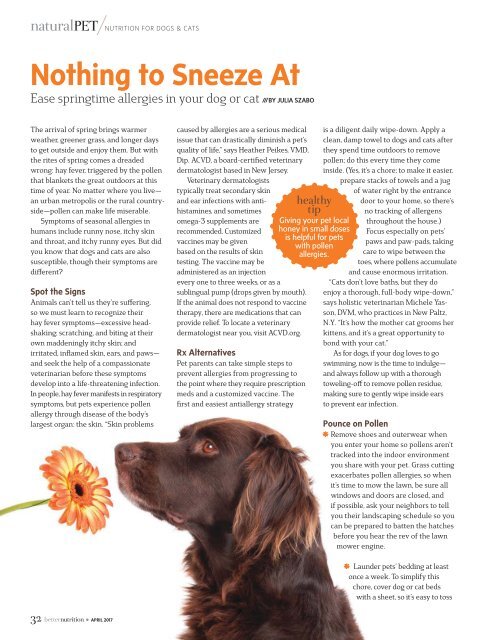magazine-pdf.org_13325_Better_Nutrition_April_2017_2
Create successful ePaper yourself
Turn your PDF publications into a flip-book with our unique Google optimized e-Paper software.
#$%&'$()*+,NUTRITION FOR DOGS & CATS<br />
Nothing to Sneeze At<br />
Ease springtime allergies in your dog or cat /// BY JULIA SZABO<br />
The arrival of spring brings warmer<br />
weather, greener grass, and longer days<br />
to get outside and enjoy them. But with<br />
the rites of spring comes a dreaded<br />
wrong: hay fever, triggered by the pollen<br />
that blankets the great outdoors at this<br />
time of year. No matter where you live—<br />
an urban metropolis or the rural countryside—pollen<br />
can make life miserable.<br />
Symptoms of seasonal allergies in<br />
humans include runny nose, itchy skin<br />
and throat, and itchy runny eyes. But did<br />
you know that dogs and cats are also<br />
susceptible, though their symptoms are<br />
different?<br />
Spot the Signs<br />
Animals can’t tell us they’re suffering,<br />
so we must learn to recognize their<br />
hay fever symptoms—excessive headshaking;<br />
scratching, and biting at their<br />
own maddeningly itchy skin; and<br />
irritated, inflamed skin, ears, and paws—<br />
and seek the help of a compassionate<br />
veterinarian before these symptoms<br />
develop into a life-threatening infection.<br />
In people, hay fever manifests in respiratory<br />
symptoms, but pets experience pollen<br />
allergy through disease of the body’s<br />
largest <strong>org</strong>an: the skin. “Skin problems<br />
caused by allergies are a serious medical<br />
issue that can drastically diminish a pet’s<br />
quality of life,” says Heather Peikes, VMD,<br />
Dip. ACVD, a board-certified veterinary<br />
dermatologist based in New Jersey.<br />
Veterinary dermatologists<br />
typically treat secondary skin<br />
and ear infections with antihistamines,<br />
and sometimes<br />
omega-3 supplements are<br />
recommended. Customized<br />
vaccines may be given<br />
based on the results of skin<br />
testing. The vaccine may be<br />
administered as an injection<br />
every one to three weeks, or as a<br />
sublingual pump (drops given by mouth).<br />
If the animal does not respond to vaccine<br />
therapy, there are medications that can<br />
provide relief. To locate a veterinary<br />
dermatologist near you, visit ACVD.<strong>org</strong>.<br />
Rx Alternatives<br />
Pet parents can take simple steps to<br />
prevent allergies from progressing to<br />
the point where they require prescription<br />
meds and a customized vaccine. The<br />
first and easiest antiallergy strategy<br />
-.$(%-/0<br />
%12<br />
Giving your pet local<br />
honey in small doses<br />
is helpful for pets<br />
with pollen<br />
allergies.<br />
is a diligent daily wipe-down. Apply a<br />
clean, damp towel to dogs and cats after<br />
they spend time outdoors to remove<br />
pollen; do this every time they come<br />
inside. (Yes, it’s a chore; to make it easier,<br />
prepare stacks of towels and a jug<br />
of water right by the entrance<br />
door to your home, so there’s<br />
no tracking of allergens<br />
throughout the house.)<br />
Focus especially on pets’<br />
paws and paw-pads, taking<br />
care to wipe between the<br />
toes, where pollens accumulate<br />
and cause enormous irritation.<br />
“Cats don’t love baths, but they do<br />
enjoy a thorough, full-body wipe-down,”<br />
says holistic veterinarian Michele Yasson,<br />
DVM, who practices in New Paltz,<br />
N.Y. “It’s how the mother cat grooms her<br />
kittens, and it’s a great opportunity to<br />
bond with your cat.”<br />
As for dogs, if your dog loves to go<br />
swimming, now is the time to indulge—<br />
and always follow up with a thorough<br />
toweling-off to remove pollen residue,<br />
making sure to gently wipe inside ears<br />
to prevent ear infection.<br />
Pounce on Pollen<br />
3 Remove shoes and outerwear when<br />
you enter your home so pollens aren’t<br />
tracked into the indoor environment<br />
you share with your pet. Grass cutting<br />
exacerbates pollen allergies, so when<br />
it’s time to mow the lawn, be sure all<br />
windows and doors are closed, and<br />
if possible, ask your neighbors to tell<br />
you their landscaping schedule so you<br />
can be prepared to batten the hatches<br />
before you hear the rev of the lawn<br />
mower engine.<br />
3<br />
Launder pets’ bedding at least<br />
once a week. To simplify this<br />
chore, cover dog or cat beds<br />
with a sheet, so it’s easy to toss<br />
!" • APRIL <strong>2017</strong>


















